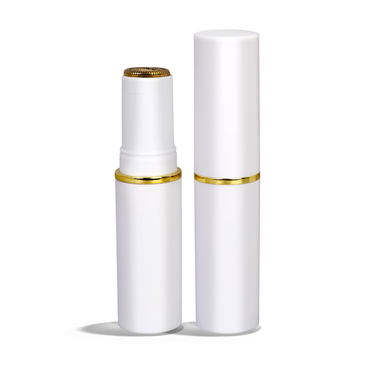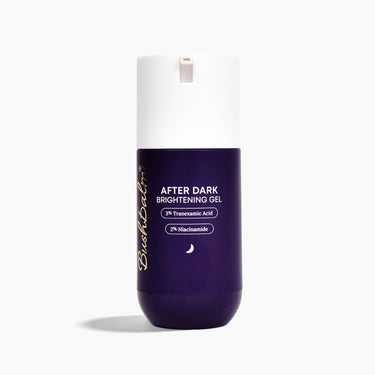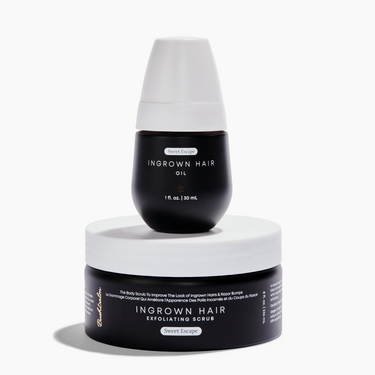How to Shave your Armpits
So you just shaved or waxed your armpits and you can't wait to raise your arms and flaunt your smooth skin...but you now have a bunch of tiny bumps, spots, and redness all over your underarms. Sound familiar? This is totally normal and honestly happens to pretty much everyone. Fortunately, there are ways to quickly treat this, and even better prevent irritation from occurring in your armpits after shaving or waxing.

Steps to shaving your armpits without irritation
Step #1 Dry Brush
Before showering, gently buff your skin with the Nordic Dry Brush.
How to Use: We recommend using this product 1-3 times a week (pre-shower). Lightly stroke the brush in an upward motion towards your heart. It may be too sensitive to use a dry brush in your armpits. If this is the case skip to step #2.

Step #2 Exfoliate your armpit with a moisturizing scrub
Use an exfoliating scrub in your underarms before you shave, as this will soften the skin and hair making the blade and skin have a gentle and non-irritating interaction. Soft skin in your armpit will allow your razor to glide effortlessly and soft hair allows the razor to cut through with little resistance. Each Bushbalm exfoliating scrub is infused with replenishing ingredients and hydrating essential oils that will coat the hair and skin leading to a softer, smooth armpit.

How to Use: Hop in the shower and soak the skin in warm water. Then, take a small amount of the Nude scrub and gently massage it into your armpits. We recommend using the scrub 2-3 times a week in the shower.
Step #3 Trim your armpit hair
Trimming your armpit before shaving is a crucial step. The Francesca Trimmer is designed to comb all the hair in the same direction and cut the hairs down to the same length. A trimmer will prevent razor bumps by minimizing any tugging the razor might do in order to slice the hair. When body hair is too long, curled, or pointing in different directions, the razor blade cannot glide as easily leading to irritation in your armpit. You may find yourself placing more pressure on the razor to get a clean, smooth shave. This pressure of dragging and re-dragging the blade over the skin will cause significant irritation and leave an angry rash of razor bumps behind.

Click here to learn about how to use the Francesca Trimmer™.
Step #4 Shave your armpit with a sharp razor
To shave your armpit with less irritation follow these guidelines:
- Shave with the grain (trimmers can help give you a better view of the direction of growth)
- Use a fresh and sharp razor
- Replace your razor at least every 10 shaves
Step #5 Treat your underarm skin with an ingrown hair oil or razor bump treatment
The Sweet Escape ingrown hair oil will hydrate and moisturize your armpit. Applying the oils within 2 minutes of showering will lead to less irritation when the hair starts to grow back. Sweet Escape Oil is infused with Tangerine Essential Oil and Vanilla Essential Oil which combine to nourish the skin and reduce irritations. It also contains tea tree oil and grape seed oil. Tea tree oil is a natural healer of ingrown hairs. This ingredient combats bacteria while the grape seed allows the mixture to dry into the skin quickly and seamlessly.

How To Use: After stepping out of the shower, massage the treatment oil into the armpit.
Common skin irritations that occur from shaving your armpits and how to prevent them
Let's address some common skin concerns that occur from shaving or waxing your armpits.
Concern 1: Ingrown Hairs
What are ingrown hairs?
An ingrown hair is a hair strand that grows back into the skin, as opposed to growing up and through the skin’s surface. Ingrown hairs are often accompanied by uncomfortable symptoms such as redness, itching, and even acne-like bumps.
What causes an ingrown hair in your armpit?
Improper hair removal: Drying shaving, shaving too often, or shaving too close to the skin falls under the category of improper hair removal. When we shave, the first blade of the razor will lift the hair strand so the next blade can slice it off. If we shave too close to the skin, by applying too much pressure or pulling the skin tight, the second blade will cut the hair below the skin line and give the hair strand a sharp edge. When it is time for the hair to grow, the sharp tip and awkward position of the cut will cause the hair strand to curl back into the skin and remain trapped beneath the skin’s surface. Click here to learn how to properly shave with a razor.
Clogged pore: Ingrown hairs are also caused by clogged pores. Normally, the hair is supposed to grow up from its root and through the pore (the skin’s opening). Pores can often become clogged by dead skin cells due to a lack of exfoliation. When the pore is clogged, the hair strand cannot break through the opening and instead will curl back down underneath the skin’s surface - causing ingrown hair.
Tight Clothing: Wearing tight clothing, especially tight undies, right after hair removal can cause ingrown hairs. If too close to the skin, the fabric will trap the hair that is beginning to grow back and force them to grow sideways.
Should I tweeze out my ingrown hair?
No! You should refrain from tweezing and tugging at ingrown hairs. This will open the pore and leave the hair follicle vulnerable to further irritation and infection. The best course of action is to keep the area dry, clean, and avoid shaving over the ingrown hair until it has cleared up.
How to prevent ingrown hairs:
The key to preventing ingrown hairs is to keep the skin exfoliated and moisturized.
Exfoliation will unclog the pores so the hair can grow through the skin rather than getting trapped underneath. Moisturizing is necessary to soften the skin and allow the new hair to break through the surface with ease.

Products to help:
You can also use the Sweet Escape Collection if you prefer. The Sweet Escape Collection is extremely hydrating and has a soft and sweet aroma of tangerine and vanilla. On the other hand, the Nude Collection has little to no scent and is meant to restore your skin’s natural moisture - rather than add extra moisture. Both collections will target, treat and prevent ingrown hairs.
The Skincare Everywhere Routine for Ingrown Hairs
Dry Brush
Before showering, gently buff your skin with our Nordic Dry Brush. Made with densely packed all-natural bristles, this brush will gently sweep away dead skin cells and unclog your pores.
How to Use: We recommend using this product 1-3 times a week (pre-shower). Lightly stroke the brush in an upward motion towards your heart.
Exfoliating Scrub
Exfoliate before shaving to soften the skin and hair. Soft skin will allow your razor to glide effortlessly and soft hair allows the razor to cut through with little resistance. Bushbalm exfoliating scrubs are packed with nourishing ingredients and essential oils that work to remove the top layer of dead skin and coat the hair - making both the hair and skin as soft as possible.
How to Use: Hop in the shower and soak the skin in warm water. Then, take a small amount of the Nude Scrub and gently massage it into your armpits. We recommend using the scrub 2-3 times a week in the shower.
Trim
Trimming before shaving is a crucial step. The Francesca Trimmer™ is designed to comb all the hair in the same direction and cut it down to the same size.
As previously mentioned, the first blade of the razor will lift the hair strand so the next blade can slice it off. If the hair strand is too long, curled, or pointing in a weird direction, the razor won’t be able to properly lift the strand. Instead, the razor will cut the strand at a weird angle. The hair could then fall below the skin line with a sharp edge. When it is time for the hair to grow, the sharp tip and awkward position of the cut will cause the hair strand to curl back into the skin, remain trapped beneath the skin’s surface, and become an ingrown hair.
How To Use: With one hand, pull the skin taut and with the other lightly press the buzzing razor head onto the skin. The Francesca Trimmer™ is safe to use and will not irritate, nic, or cut your skin in the process of trimming. Click here to learn more about how to use the Francesca Trimmer™.
Shave
Shave with the grain! That is, move the razor in the same direction that your hair grows. Trimming the armpit hair before shaving will give you a better view of the skin and the direction of growth. Also, make sure your razor is sharp. A sharp blade will remove as much hair as possible with minimal strokes. We recommend replacing your blade at least every ten shaves. Click here to learn how to properly shave with a razor.
Treat
Made from the highest quality of natural oils to ensure a soft and luxurious feeling on your skin Nude Oil quickly soothes ingrown hairs, redness, bumps, and irritations caused by hair removal. Nude Oil is infused with Jojoba and Copaiba oils that work to soften the skin and soothe skin irritations. It also contains tea tree oil and grape seed oil: tea tree is a natural healer that protects the skin from bacteria while the grape seed allows the mixture to dry into the skin quickly and seamlessly.
How To Use: After stepping out of the shower, massage the treatment oil into the armpit.
Concern 2: Dark Spots
What are Dark Spots?
Hyperpigmentation (or dark spots) refers to patches of skin that are darker in colour than the skin surrounding it. This contrast of light and dark patches creates the appearance of an uneven skin tone. This skin condition can affect all races.
What causes dark spots?
Patches of hyperpigmentation form as a result of an increase in melanin production; melanin is a pigment that gives the skin, eyes, and hair their natural colour. The extra melanin settles in the skin in the form of melanin deposits. Melanin deposits create dark spots that appear on the surface of the skin. Increased melanin production can be triggered by:
Sun exposure: Sunlight is a major cause of hyperpigmentation. Sunlight exposure can stimulate melanocyte skin cells that attempt to give the skin protection from excessive sun exposure; melanocytes produce the brown melanin pigment. Melanin is responsible for making the skin appear more tan, but when melanocytes produce too much melanin, the distribution becomes uneven, creating patches of the skin’s surface a darker colour.
Skin Injuries/inflammation: Post-inflammatory hyperpigmentation is caused by abrasions to the skin's surface; including but not limited to acne, eczema, or skin injuries. The inflammation that results from an injury triggers melanocyte skin cells to the area of injury. The excessive concentration of melanocytes will leave a darker and discoloured patch around the area where the wound once was.
Age: Age can bring about dark spots on the skin. Though age spots are most commonly experienced past the age of 50, they can also occur at a younger age. Age spots form as a result of an overproduction of melanin skin cells. After years of sun exposure, over time the body will produce higher concentrations of melanin which eventually create melanin deposits or dark spots.
The common denominator of each cause is excess melanin in the skin. The listed causes are just some of the sources of dark spots - click here to learn more about what triggers dark spots.
Why does excess melanin create dark spots and not an even darker complexion?
According to AEDIT, one’s skin tone will have an even colour “when the body is processing normal levels of melanin”. However, if there is excess melanin production in the body, the melanin will disperse unevenly forming melanin deposits that appear to be dark spots on the surface - to read more about uneven skin tone/texture click here.
Products to help:
How to treat Dark Spots:
The Bermuda Oil and Scrub work together to reduce the appearance of dark spots and help prevent future occurrences of hyperpigmentation. Both products contain ingredients to break up the melanin pigments that cause dark spots, uneven skin tones, and hyperpigmentation - click here to learn more about the Bermuda Collection.
The Skincare Everywhere Routine for Dark Spots
Dry Brush
Routine exfoliation will speed up the fading process of dark spots by breaking up the dark pigmented cells on the surface of the skin. However, we understand that not everyone has time to hop in the shower and do a full exfoliation routine. The Nordic Dry Brush is the perfect option for those days when you’re on the go. At the risk of stating the obvious, the brush should be used on dry skin.
How to use: Lightly stroke the brush on your armpit in an upward motion. Over time, this routine will help break up dark spots and aid the fading process.
Bermuda Scrub
This scrub is specifically designed to soften the skin and break down the melanin pigments on the surface of the skin. The Bermuda Scrub is infused with nourishing ingredients, such as lemon essential oil, that will lighten dark spots and brighten the skin. Over time and with consistent use, this product will fade the appearance of dark spots.
Click here to learn how to use the Bermuda Scrub and when to use it in your skincare everywhere routine.
Bermuda Treatment Oil
The Bermuda Oil formula will gently break down melanin that's built up in the skin and over time achieve a more even skin tone.
Click here to learn how to use the Bermuda Oil and when to use it in your skincare everywhere routine.

Concern 3: Razor Bumps
What are razor bumps?
Shaving is a convenient and easy way to get rid of unwanted hair, however razor bumps are a common side effect. Razor bumps are the result of an unpleasant interaction between the razor blade, body hair, and skin. The symptoms of razor bumps include; redness, irritation, discomfort, and stinging. Click here to learn more about what razor bumps are and how to prevent them.
What causes razor bumps?
Dull razor: When your razor is dull, it requires more passes on a given area to sufficiently remove the hair. The extra strokes cause significant irritation and cause micro-abrasions (little cuts) on the surface. The abrasions leave the skin vulnerable to infection and irritation - causing the dreaded rashy razor bumps to appear in the most delicate places.
Lack of proper cleaning: Throughout the day, dirt and oil accumulate on the surface of our skin. If you remove hair without properly cleaning the area beforehand, you run the risk of infecting the freshly opened hair follicles. Oils and dirt can seep into your skin causing a red and angry rash to appear in its place.
Dryness: Dryness upon hair removal can leave your skin vulnerable to irritation. When the skin lacks moisture, it can become rough. Dragging a razor on an already rough surface can aggravate the skin and lead to uncomfortable razor bumps.
Click here to learn more about what causes razor bumps.
How to prevent razor bumps:
To prevent razor bumps your skincare routine should adequately prep the skin with a thorough clean and contain products to soothe the skin before and after hair removal. Click here to find the ideal routine to treat razor bumps.
Products to help:
You can also use the Nude Collection if you prefer. The Nude Collection is virtually scentless and is meant to restore your skin’s natural moisture - not add extra moisture. On the other hand, the Sweet Escape Collection is ultra-hydrating and has a soft and sweet aroma of tangerine and vanilla, similar to a creamsicle. Both collections work to tackle and prevent razor bumps.























